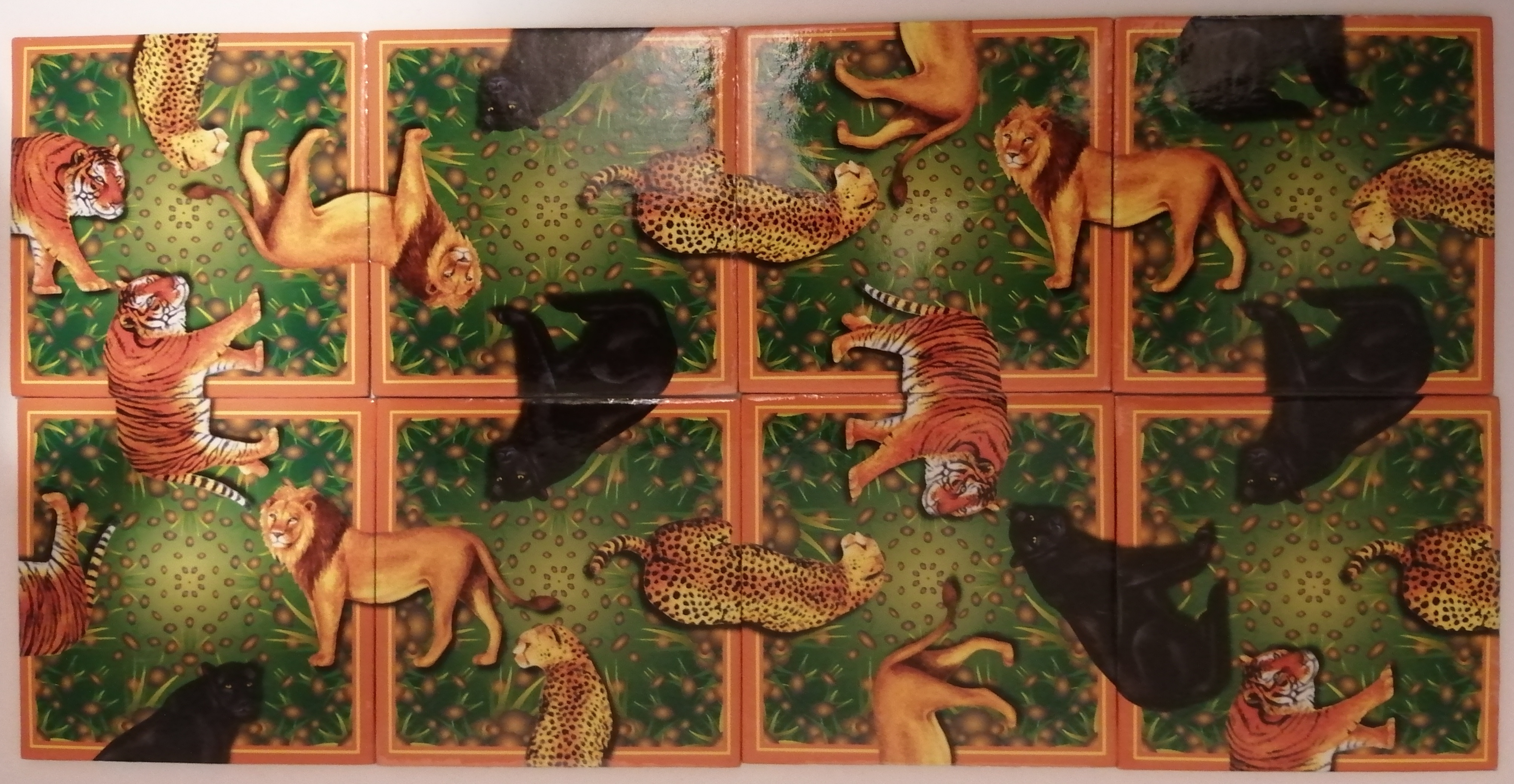The puzzle
My roomate bought me a kid puzzle, from the second hand shop.
The puzzle consists in putting the puzzle pieces in a 3x3 grid, such that all the animals on the edges match.
It might look like an easy puzzle, but once, trying to solve the puzzle with my friends, we took a good 30 min to try to solve the puzzle. I already gave up on the puzzle after 5 min of trial, after I realized there are 9!⋅49 (95126814720) possible formation of the puzzle.
So I decided to code a program that would solve the problem.
I decided to program a solver of the puzzle using Integer Programming.

Solving the puzzle with Integer Programming
Values
There are 8 possible animal part on the edges of the tiles, them being:
- Jaguar front → JF
- Jaguar back → JB
- Panther front → PF
- Panther back → PB
- Tiger front → TF
- Tiger back → TB
- Lion front → LF
- Lion back → LB
I gave each animal part a representative values such that matching values add up to 0 but non matching values do not add up to 0.
e.g.
JF+JB=0
JF+TB=0
In my implementation, I used the following values.
|
Tiger |
Lion |
Panther |
Jaguar |
| Front |
1 |
2 |
3 |
4 |
| Back |
-1 |
-2 |
-3 |
-4 |
Tile
All possible tiles
JB JF LF TF TB PF LB PB PB
TF 0 TB JB 1 LB LB 2 TB TF 3 JF TB 4 LF TF 5 LB PB 6 PB JB 7 LF TF 8 PF
LF PF JF LB PF JF JF PF JB
The variable tilei,rot
The variable tilei,rot is a variable that stores the ith tile with a rotation of rot⋅90° degree clockwise.
e.g.
left(tile0,0)=TF=1
top(tile1,1)=JB=−4
It is obvious that the following properties hold.
left(tilei,rot)=top(tilei,rot+1)
top(tilei,rot)=right(tilei,rot+1)
right(tilei,rot)=bottom(tilei,rot+1)
bottom(tilei,rot)=left(tilei,rot+1)
The Variables of the ILP
ti,rot,pos are the integer program variables.
i stands for the ith tile, rot stands for
the rot⋅90° degree clockwise rotation that the tile will be
configured in, and pos stands for the position of the tile in a 3x3
configuration, if each position is indexed the following way:
The Constraints of the ILP
For each tile, one state only must exist
∀i∑rot∑posti,rot,pos=1
For each slot, one tile only must exist
∀pos∑i∑rotti,rot,pos=1
Side matching
∑i∑rotright(tilei,rot)⋅ti,rot,0+∑i∑rotleft(tilei,rot)⋅ti,rot,1=0
∑i∑rotright(tilei,rot)⋅ti,rot,1+∑i∑rotleft(tilei,rot)⋅ti,rot,2=0
∑i∑rotright(tilei,rot)⋅ti,rot,3+∑i∑rotleft(tilei,rot)⋅ti,rot,4=0
∑i∑rotright(tilei,rot)⋅ti,rot,4+∑i∑rotleft(tilei,rot)⋅ti,rot,5=0
∑i∑rotright(tilei,rot)⋅ti,rot,6+∑i∑rotleft(tilei,rot)⋅ti,rot,7=0
∑i∑rotright(tilei,rot)⋅ti,rot,7+∑i∑rotleft(tilei,rot)⋅ti,rot,8=0
Top and bottom matching
∑i∑rotbottom(tilei,rot)⋅ti,rot,0+∑i∑rottop(tilei,rot)⋅ti,rot,3=0
∑i∑rotbottom(tilei,rot)⋅ti,rot,1+∑i∑rottop(tilei,rot)⋅ti,rot,4=0
∑i∑rotbottom(tilei,rot)⋅ti,rot,2+∑i∑rottop(tilei,rot)⋅ti,rot,5=0
∑i∑rotbottom(tilei,rot)⋅ti,rot,3+∑i∑rottop(tilei,rot)⋅ti,rot,6=0
∑i∑rotbottom(tilei,rot)⋅ti,rot,4+∑i∑rottop(tilei,rot)⋅ti,rot,7=0
∑i∑rotbottom(tilei,rot)⋅ti,rot,5+∑i∑rottop(tilei,rot)⋅ti,rot,8=0
The program and the solution
The program can be found here.
The output of the program is:
JF PF LB
TF 3 LB LF 7 JB JF 2 LF
TF PB TB
TB PF TF
PF 4 TB TF 5 LB LF 0 JB
LF JF TB
LB JB TF
PB 6 PB PF 1 JF JB 8 PB
JF LB PF
Which translates to the following configuration.

Fun Fact
You can still play the game if you lose any piece with a 2x4 formation.

All the possible 8 pieces out of the 9 pieces have a solution with a 2x4 formation.
See also


